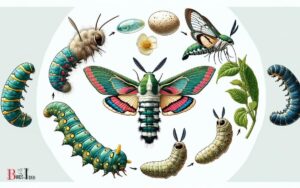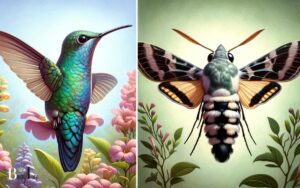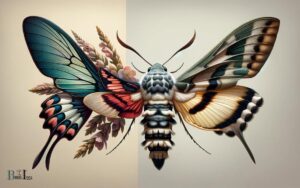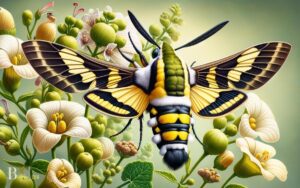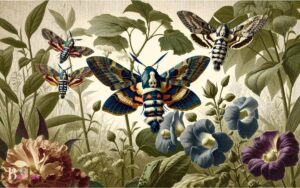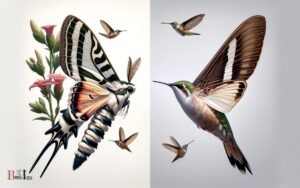How to Attract Hummingbird Moths? Discover!
To attract hummingbird moths to your garden, it’s important to plant nectar-rich flowers that bloom at night or during dusk, such as evening primrose, honeysuckle, and moonflowers.
Additionally, maintaining a water feature for moisture, minimizing light pollution, and avoiding the use of pesticides can create an ideal habitat for these nocturnal pollinators.
Hummingbird moths, also known as hawk moths or sphinx moths, are attracted to gardens that offer ample food sources and a safe environment.
They primarily feed on nectar and are particularly drawn to white or pale-colored flowers that open in the late afternoon or evening. Their long proboscises allow them to feed while hovering, similar to hummingbirds.
Here are some key factors to consider:
Invite the enchanting dance of hummingbird moths to your garden with the right blooms and a tranquil, chemical-free oasis.
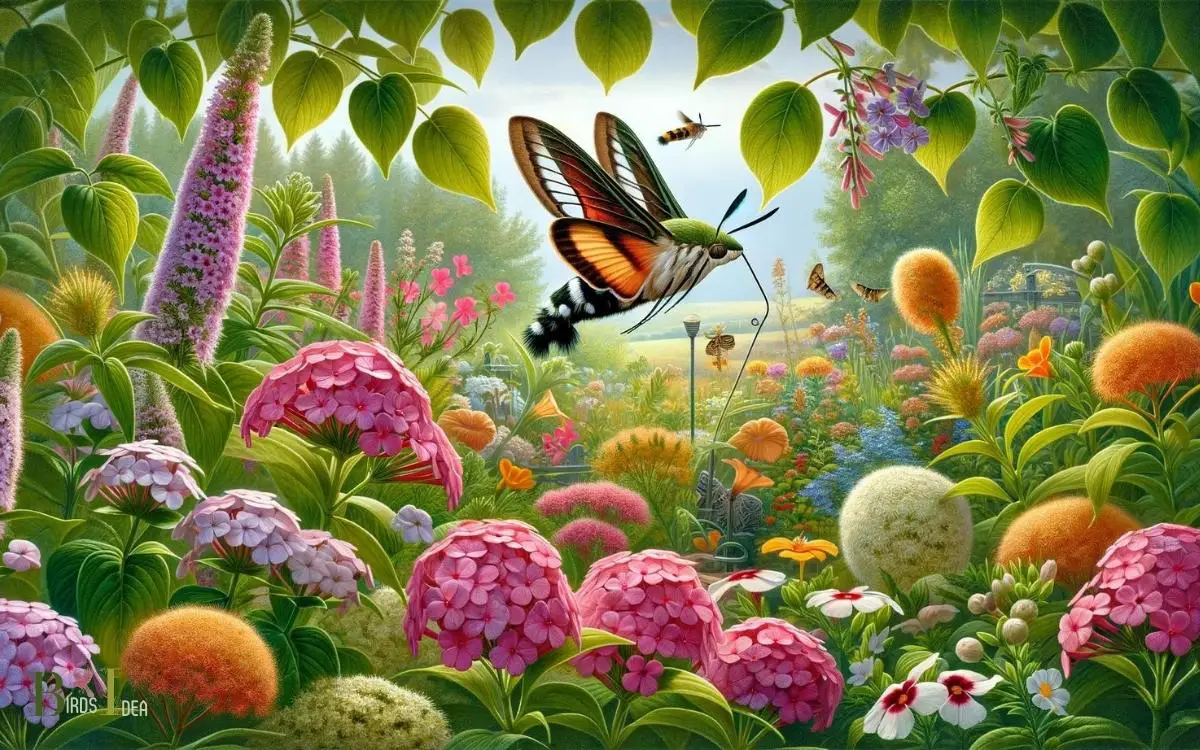
Key Takeaway
Best Flowers to Create a Hummingbird Moth-Friendly Garden
| Flower Type | Bloom Period | Color | Additional Benefits |
|---|---|---|---|
| Evening Primrose | Dusk to dawn | Yellow, white | Fragrant, attracts other pollinators |
| Honeysuckle | Late afternoon | Various | Hardy, sweet scent |
| Moonflower | Evening to night | White | Large blooms, fast-growing |
| Jasmine | Evening | White to pale | Intense fragrance |
| Phlox | Dusk to night | Pale to bright | Variety of colors, easy to grow |
| Petunia | Day to dusk | Various | Long blooming period |
| Nicotiana | Evening to night | White to pink | Star-shaped flowers, fragrant |
| Four O’Clocks | Late afternoon | Various | Self-seeding, colorful |
| Salvia | Dusk to dawn | Red, purple | Attracts hummingbirds as well |
| Bee Balm (Monarda) | Day to dusk | Red, pink | Medicinal uses, native variety |
Understanding Hummingbird Moths
Hummingbird moths are often mistaken for actual hummingbirds due to their similar appearance and hovering behavior while feeding on nectar.
These moths have plump, furry bodies and long, narrow wings that beat rapidly, allowing them to hover in front of flowers just like hummingbirds.
They’re often active during the day and are drawn to brightly colored flowers with sweet scents, especially those with tubular shapes that allow them to easily access the nectar with their long proboscis.
Understanding the behavior and preferences of hummingbird moths is crucial in attracting them to a garden.
By choosing the right flowers and creating an environment that mimics their natural habitat, it’s possible to attract these fascinating creatures and enjoy their presence in the garden.
Choosing the Right Flowers
When attracting hummingbird moths, it’s important to choose flowers with bright colors and sweet scents to mimic their natural preferences.
Brightly colored flowers, such as red, orange, and pink, are highly attractive to hummingbird moths.
These moths are especially drawn to tubular flowers, such as honeysuckle, bee balm, and petunias, which allow them to easily access nectar with their long proboscis.
Additionally, flowers with a strong, sweet fragrance, like jasmine, phlox, and nicotiana, are particularly appealing to these moths.
It’s also essential to select flowers that bloom at different times throughout the day and night to ensure a consistent nectar source.
Providing a Water Source
Hummingbird moths, like other pollinators, require access to water for hydration. Providing a water source in the garden is essential for attracting and supporting these unique creatures.
This can be achieved through the use of shallow dishes, birdbaths, or even moist soil patches.
Water for Pollinators
Pollinators benefit from having access to water sources for hydration and sustenance. Providing a water source in your garden can help attract and support these essential creatures.
Here are four ways to provide a water source for pollinators:
- Shallow dishes or bowls: Fill shallow dishes or bowls with water and place them in different areas of your garden. Make sure to add some small rocks or marbles to provide landing spots for insects.
- Dripping water feature: Install a dripping water feature, such as a small fountain or a dripper attached to a hose, to create a continuous water source for pollinators.
- Wet sand or mud patch: Create a wet sand or mud patch in a sunny area of your garden. Many pollinators, especially butterflies, bees, and wasps, benefit from accessing minerals from damp soil.
- Keep it clean: Regularly clean and refill the water sources to prevent the growth of algae and to ensure that the water is safe for pollinators to drink.
Importance of Hydration
An important aspect of attracting hummingbird moths is providing a consistent water source for their hydration and sustenance. Hummingbird moths, like their avian namesakes, require hydration to survive and thrive.
Offering a water source in your garden or outdoor space can significantly increase the likelihood of attracting these fascinating creatures.
A shallow dish filled with water and some pebbles for them to perch on can serve as an ideal watering spot.
Additionally, incorporating plants that provide natural sources of moisture, such as nectar-producing flowers, can further support their hydration needs.
Creating a Sheltered Environment
To attract hummingbird moths, gardeners should provide a sheltered environment that offers protection from strong winds and excessive sunlight.
Creating a conducive habitat will increase the likelihood of attracting these fascinating creatures to the garden.
Here are some key considerations for creating a sheltered environment:
- Strategic Plant Placement: Positioning taller plants or shrubs around the garden perimeter can help create a natural barrier against strong winds, providing a more sheltered microclimate.
- Utilize Garden Structures: Installing trellises, fences, or garden walls can offer protection from direct sunlight and wind, creating a more sheltered environment for hummingbird moths to thrive.
- Provide Shade: Planting trees or incorporating shade-providing structures can help create areas of refuge from excessive sunlight, making the garden more appealing to hummingbird moths.
- Windbreaks: Implementing windbreaks such as hedges or wind-resistant plants can significantly reduce the impact of strong winds, creating a more hospitable environment for hummingbird moths.
Avoiding Pesticides
One effective way to attract hummingbird moths is by avoiding the use of pesticides in the garden.
Pesticides, while effective at controlling pests, can also harm beneficial insects like hummingbird moths.
These moths are important pollinators and play a role in maintaining a healthy ecosystem. By opting for natural pest control methods, gardeners can create a safer environment for hummingbird moths to thrive.
Here’s a comparison table to highlight the differences between pesticide and natural pest control methods:
| Pesticides | Natural Pest Control |
|---|---|
| Kills beneficial insects | Maintains ecological balance |
| Harmful to pollinators | Safe for pollinators |
| Chemical residues | Environmentally friendly |
| Risk to human health | Non-toxic |
| Short-term solution | Sustainable approach |
Can Hummingbird Moths be Attracted Using the Same Methods as Hummingbirds?
Attracting hummingbird moths using the same methods as hummingbirds can be effective based on their similar hummingbird moths feeding habits. Planting nectar-rich flowers such as bee balm, salvia, and petunias can attract both hummingbirds and hummingbird moths, creating a beautiful and lively garden ecosystem.
Observing and Enjoying
Gardeners can enhance their experience by observing and enjoying the graceful flight patterns of hummingbird moths as they dart from flower to flower in search of nectar.
These fascinating creatures provide a delightful display in the garden, and by taking the time to observe them, gardeners can gain a deeper appreciation for their role in pollination and ecological balance.
To fully enjoy the presence of hummingbird moths in the garden, consider the following tips:
- Sit quietly near their favorite flowers to watch their aerial acrobatics.
- Observe their unique feeding behavior, hovering in front of flowers much like hummingbirds.
- Keep a journal to track their visiting times and preferred nectar sources.
- Take photographs or videos to capture their beauty and share with others.
Conclusion
Attracting hummingbird moths is like orchestrating a beautiful dance of nature.
By planting the right flowers, providing a refreshing water source, and creating a cozy sheltered environment, you can entice these delightful creatures to grace your garden with their presence.
So sit back, observe their graceful movements, and enjoy the magical display of nature right in your own backyard. It’s a symphony of life that’s sure to enchant and delight.

